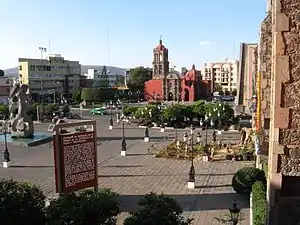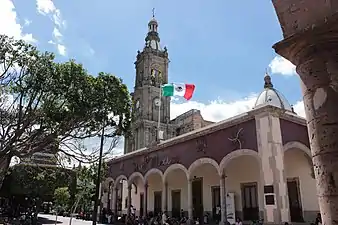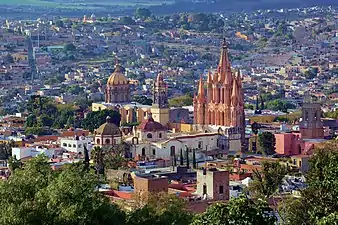.svg.png.webp)
Guanajuato is a state in North Central Mexico that is divided into 46 municipalities.[1] According to the 2020 Mexican census, Guanajuato is the sixth most populous state with 6,166,934 inhabitants and the 22nd largest by land area spanning 30,691.61 square kilometres (11,850.10 sq mi).[1][2]
Municipalities in Guanajuato are administratively autonomous of the state according to the 115th article of the 1917 Constitution of Mexico.[3] Every three years, citizens elect a municipal president (Spanish: presidente municipal) by a plurality voting system who heads a concurrently elected municipal council (ayuntamiento) responsible for providing all the public services for their constituents. The municipal council consists of a variable number of trustees and councillors (regidores y síndicos).[4] Municipalities are responsible for public services (such as water and sewerage), street lighting, public safety, traffic, and the maintenance of public parks, gardens and cemeteries.[5] They may also assist the state and federal governments in education, emergency fire and medical services, environmental protection and maintenance of monuments and historical landmarks. Since 1984, they have had the power to collect property taxes and user fees, although more funds are obtained from the state and federal governments than from their own income.[5]
The largest municipality by population in Guanajuato and third largest in Mexico is León, with 1,721,215 residents or approximately 27.9% of the state population.[1] The smallest municipality by population is Atarjea with 5,296 residents.[1] The largest municipality by land area is San Felipe which spans 3,014.92 km2 (1,164.07 sq mi), and the smallest is Pueblo Nuevo which spans 60.05 km2 (23.18 sq mi).[2] The first state constitution, Constitución Política del Estado Libre de Guanajuato, resulted in the formation of the first 17 municipalities in Guanajuato on April 15, 1826.[6][7] The newest municipality is Doctor Mora, incorporated on September 22, 1935.[7]
Municipalities
- Municipalities in Guanajuato
 León, Guanajuato's largest municipality by population
León, Guanajuato's largest municipality by population Irapuato, second largest municipality by population.
Irapuato, second largest municipality by population. Celaya, third largest municipality by population.
Celaya, third largest municipality by population. Salamanca, fourth largest municipality by population.
Salamanca, fourth largest municipality by population. Silao, fifth largest municipality by population.
Silao, fifth largest municipality by population. Guanajuato, capital city and sixth largest municipality by population.
Guanajuato, capital city and sixth largest municipality by population. San Miguel de Allende, seventh largest municipality by population.
San Miguel de Allende, seventh largest municipality by population.
| Name | Municipal seat | Population (2020)[1] |
Population (2010)[8] |
Change | Land area[2] | Population density (2020) |
Incorporation date[7] | |
|---|---|---|---|---|---|---|---|---|
| km2 | sq mi | |||||||
| Abasolo | Abasolo | 92,040 | 84,332 | +9.1% | 617.05 | 238.24 | 149.2/km2 (386.3/sq mi) | January 14, 1870 |
| Acámbaro | Acámbaro | 108,697 | 109,030 | −0.3% | 880.31 | 339.89 | 123.5/km2 (319.8/sq mi) | April 14, 1826 |
| Apaseo el Alto | Apaseo el Alto | 63,392 | 64,433 | −1.6% | 374.95 | 144.77 | 169.1/km2 (437.9/sq mi) | May 16, 1885 |
| Apaseo el Grande[lower-alpha 1] | Apaseo el Grande | 117,883 | 85,319 | +38.2% | 421.60 | 162.78 | 279.6/km2 (724.2/sq mi) | April 14, 1826 |
| Atarjea | Atarjea | 5,296 | 5,610 | −5.6% | 314.93 | 121.59 | 16.8/km2 (43.6/sq mi) | May 16, 1885 |
| Celaya | Celaya | 521,169 | 468,469 | +11.2% | 554.62 | 214.14 | 939.7/km2 (2,433.8/sq mi) | April 14, 1826 |
| Comonfort[lower-alpha 2] | Comonfort | 82,216 | 77,794 | +5.7% | 490.03 | 189.20 | 167.8/km2 (434.5/sq mi) | May 16, 1885 |
| Coroneo | Coroneo | 11,083 | 11,691 | −5.2% | 124.16 | 47.94 | 89.3/km2 (231.2/sq mi) | May 16, 1885 |
| Cortazar | Cortazar | 97,928 | 88,397 | +10.8% | 336.16 | 129.79 | 291.3/km2 (754.5/sq mi) | May 16, 1885 |
| Cuerámaro[lower-alpha 3] | Cuerámaro | 30,857 | 27,308 | +13.0% | 261.05 | 100.79 | 118.2/km2 (306.1/sq mi) | May 16, 1885 |
| Doctor Mora[lower-alpha 4] | Doctor Mora | 27,390 | 23,324 | +17.4% | 231.44 | 89.36 | 118.3/km2 (306.5/sq mi) | September 22, 1935 |
| Dolores Hidalgo[lower-alpha 5] | Dolores Hidalgo | 163,038 | 148,173 | +10.0% | 1,660.25 | 641.03 | 98.2/km2 (254.3/sq mi) | April 14, 1826 |
| Guanajuato† | Guanajuato | 194,500 | 171,709 | +13.3% | 1,016.92 | 392.64 | 191.3/km2 (495.4/sq mi) | April 14, 1826 |
| Huanímaro | Huanímaro | 21,128 | 20,117 | +5.0% | 127.89 | 49.38 | 165.2/km2 (427.9/sq mi) | December 20, 1891 |
| Irapuato | Irapuato | 592,953 | 529,440 | +12.0% | 853.44 | 329.52 | 694.8/km2 (1,799.5/sq mi) | April 14, 1826 |
| Jaral del Progreso | Jaral del Progreso | 38,782 | 36,584 | +6.0% | 175.89 | 67.91 | 220.5/km2 (571.1/sq mi) | July 1, 1913 |
| Jerécuaro | Jerécuaro | 49,517 | 50,832 | −2.6% | 885.61 | 341.94 | 55.9/km2 (144.8/sq mi) | July 18, 1827 |
| León | León | 1,721,215 | 1,436,480 | +19.8% | 1,224.91 | 472.94 | 1,405.2/km2 (3,639.4/sq mi) | April 14, 1826 |
| Manuel Doblado[lower-alpha 6] | Ciudad Manuel Doblado | 41,240 | 37,145 | +11.0% | 822.14 | 317.43 | 50.2/km2 (129.9/sq mi) | April 14, 1826 |
| Moroleón | Moroleón | 47,261 | 49,364 | −4.3% | 160.21 | 61.86 | 295.0/km2 (764.0/sq mi) | July 13, 1877 |
| Ocampo | Ocampo | 26,383 | 22,683 | +16.3% | 1,029.01 | 397.30 | 25.6/km2 (66.4/sq mi) | May 16, 1885 |
| Pénjamo | Pénjamo | 154,960 | 149,936 | +3.4% | 1,565.52 | 604.45 | 99.0/km2 (256.4/sq mi) | April 14, 1826 |
| Pueblo Nuevo | Pueblo Nuevo | 12,403 | 11,169 | +11.0% | 60.05 | 23.18 | 206.6/km2 (535.0/sq mi) | May 16, 1885 |
| Purísima del Rincón | Purísima de Bustos | 83,842 | 68,795 | +21.9% | 291.49 | 112.54 | 287.6/km2 (745.0/sq mi) | March 22, 1867 |
| Romita | Romita | 65,766 | 56,655 | +16.1% | 441.94 | 170.63 | 148.8/km2 (385.4/sq mi) | May 16, 1885 |
| Salamanca | Salamanca | 273,417 | 260,732 | +4.9% | 757.73 | 292.56 | 360.8/km2 (934.6/sq mi) | April 14, 1826 |
| Salvatierra | Salvatierra | 94,126 | 97,054 | −3.0% | 594.58 | 229.57 | 158.3/km2 (410.0/sq mi) | April 14, 1826 |
| San Diego de la Unión | San Diego de la Unión | 41,054 | 37,103 | +10.6% | 1,015.81 | 392.21 | 40.4/km2 (104.7/sq mi) | May 16, 1885 |
| San Felipe | San Felipe | 119,793 | 106,952 | +12.0% | 3,014.92 | 1,164.07 | 39.7/km2 (102.9/sq mi) | April 14, 1826 |
| San Francisco del Rincón | San Francisco del Rincón | 130,871 | 113,570 | +15.2% | 426.56 | 164.69 | 306.8/km2 (794.6/sq mi) | March 22, 1867 |
| San José Iturbide | San José Iturbide | 89,558 | 72,411 | +23.7% | 549.67 | 212.23 | 162.9/km2 (422.0/sq mi) | December 3, 1849 |
| San Luis de la Paz | San Luis de la Paz | 128,536 | 115,656 | +11.1% | 2,036.79 | 786.41 | 63.1/km2 (163.4/sq mi) | April 14, 1826 |
| San Miguel de Allende | San Miguel de Allende | 174,615 | 160,383 | +8.9% | 1,558.14 | 601.60 | 112.1/km2 (290.3/sq mi) | April 14, 1826 |
| Santa Catarina | Santa Catarina | 5,723 | 5,120 | +11.8% | 195.30 | 75.40 | 29.3/km2 (75.9/sq mi) | May 16, 1885 |
| Santa Cruz de Juventino Rosas | Santa Cruz de Juventino Rosas | 82,340 | 79,214 | +3.9% | 430.29 | 166.14 | 191.4/km2 (495.6/sq mi) | May 16, 1885 |
| Santiago Maravatío | Santiago Maravatío | 6,714 | 6,670 | +0.7% | 83.86 | 32.38 | 80.1/km2 (207.4/sq mi) | May 16, 1885 |
| Silao de la Victoria | Silao de la Victoria | 203,556 | 173,024 | +17.6% | 540.01 | 208.50 | 376.9/km2 (976.3/sq mi) | April 14, 1826 |
| Tarandacuao [lower-alpha 7] | Tarandacuao | 11,304 | 11,641 | −2.9% | 121.14 | 46.77 | 93.3/km2 (241.7/sq mi) | May 16, 1885 |
| Tarimoro | Tarimoro | 35,905 | 35,571 | +0.9% | 335.18 | 129.42 | 107.1/km2 (277.4/sq mi) | May 16, 1885 |
| Tierra Blanca | Tierra Blanca | 20,007 | 18,175 | +10.1% | 410.48 | 158.49 | 48.7/km2 (126.2/sq mi) | May 16, 1885 |
| Uriangato | Uriangato | 61,494 | 59,305 | +3.7% | 116.68 | 45.05 | 527.1/km2 (1,365.1/sq mi) | May 16, 1885 |
| Valle de Santiago | Valle de Santiago | 150,054 | 141,058 | +6.4% | 821.98 | 317.37 | 182.6/km2 (472.8/sq mi) | April 14, 1826 |
| Victoria | Victoria | 21,253 | 19,820 | +7.2% | 1,050.19 | 405.48 | 20.2/km2 (52.4/sq mi) | December 3, 1849 |
| Villagrán | Villagrán | 65,791 | 55,782 | +17.9% | 128.85 | 49.75 | 510.6/km2 (1,322.5/sq mi) | July 20, 1930 |
| Xichú | Xichú | 11,143 | 11,560 | −3.6% | 913.65 | 352.76 | 12.2/km2 (31.6/sq mi) | May 16, 1885 |
| Yuriria (Yuririapúndaro) | Yuriria | 68,741 | 70,782 | −2.9% | 668.25 | 258.01 | 102.9/km2 (266.4/sq mi) | April 14, 1826 |
| Guanajuato | — | 6,166,934 | 5,486,372 | +12.4% | 30,691.61 | 11,850.10 | 200.9/km2 (520.4/sq mi) | — |
| Mexico | — | 126,014,024 | 112,336,538 | +12.2% | 1,972,550 | 761,606 | 63.9/km2 (165.5/sq mi) | — |
Notes
- ↑ The municipality's name was changed from Apaseo on February 22, 1957 to avoid confusion with the neighboring municipality of Apaseo el Alto.[9]
- ↑ The municipality's name was changed from Chamacuero on December 20, 1891.[10]
- ↑ The municipality's name was changed from Cuerámaro de Degollado on July 7, 1968.[11]
- ↑ The municipality's name was changed from Charcas on July 7, 1968.[12]
- ↑ The municipality's full name is Dolores Hidalgo, Cuna de la Independencia Nacional.[13]
- ↑ The municipality's name was changed from San Pedro Piedra Gorda December 16, 1899.[14]
- ↑ The municipality's name was changed from Tarandacuao de la Constancia July 28, 1989.[15]
References
- 1 2 3 4 5 "Censo de Población y Vivienda 2020 - SCITEL" (in Spanish). INEGI. Retrieved 2021-01-27.
- 1 2 3 "Unidad de Microrregiones Cédulas de Información Municipal (SCIM)" (in Spanish). Secretaría de Desarrollo Social. Archived from the original on December 31, 2017. Retrieved November 18, 2017.
- ↑ "Constitución Política de los Estados Unidos Mexicanos". Article 115, Act of 1917 (in Spanish). Retrieved September 27, 2017.
- ↑ OECD (November 12, 2004). New Forms of Governance for Economic Development. OECD Publishing. p. 121. ISBN 9264015329.
- 1 2 International Business Publications (2009). Mexico Company Laws and Regulations Handbook. p. 42. ISBN 978-1-4330-7030-3.
{{cite book}}:|last=has generic name (help) - ↑ Gobierno de México (1824). "Constitución Federal de los Estados Unidos Mexicanos" (PDF). UNAM.mx. Archived from the original (PDF) on March 3, 2016. Retrieved March 13, 2019.
- 1 2 3 Estado de Guanajuato. División Territorial de 1810 a 1995 (PDF) (in Spanish). Mexico: INEGI. 1996. pp. 75–82. ISBN 970-13-1491-3. Archived (PDF) from the original on January 4, 2018.
- ↑ "Localidades y su población por municipio según tamaño de localidad" (PDF) (in Spanish). INEGI. Retrieved March 23, 2019.
- ↑ Estado de Guanajuato. División Territorial de 1810 a 1995 (PDF) (in Spanish). Mexico: INEGI. 1996. p. 7782. ISBN 978-970-13-1491-3.
- ↑ Estado de Guanajuato. División Territorial de 1810 a 1995 (PDF) (in Spanish). Mexico: INEGI. 1996. p. 93. ISBN 978-970-13-1491-3.
- ↑ Estado de Guanajuato. División Territorial de 1810 a 1995 (PDF) (in Spanish). Mexico: INEGI. 1996. p. 95. ISBN 978-970-13-1491-3.
- ↑ Estado de Guanajuato. División Territorial de 1810 a 1995 (PDF) (in Spanish). Mexico: INEGI. 1996. p. 96. ISBN 978-970-13-1491-3.
- ↑ Estado de Guanajuato. División Territorial de 1810 a 1995 (PDF) (in Spanish). Mexico: INEGI. 1996. p. 96. ISBN 978-970-13-1491-3.
- ↑ Estado de Guanajuato. División Territorial de 1810 a 1995 (PDF) (in Spanish). Mexico: INEGI. 1996. p. 92. ISBN 978-970-13-1491-3.
- ↑ Estado de Guanajuato. División Territorial de 1810 a 1995 (PDF) (in Spanish). Mexico: INEGI. 1996. p. 121. ISBN 978-970-13-1491-3.